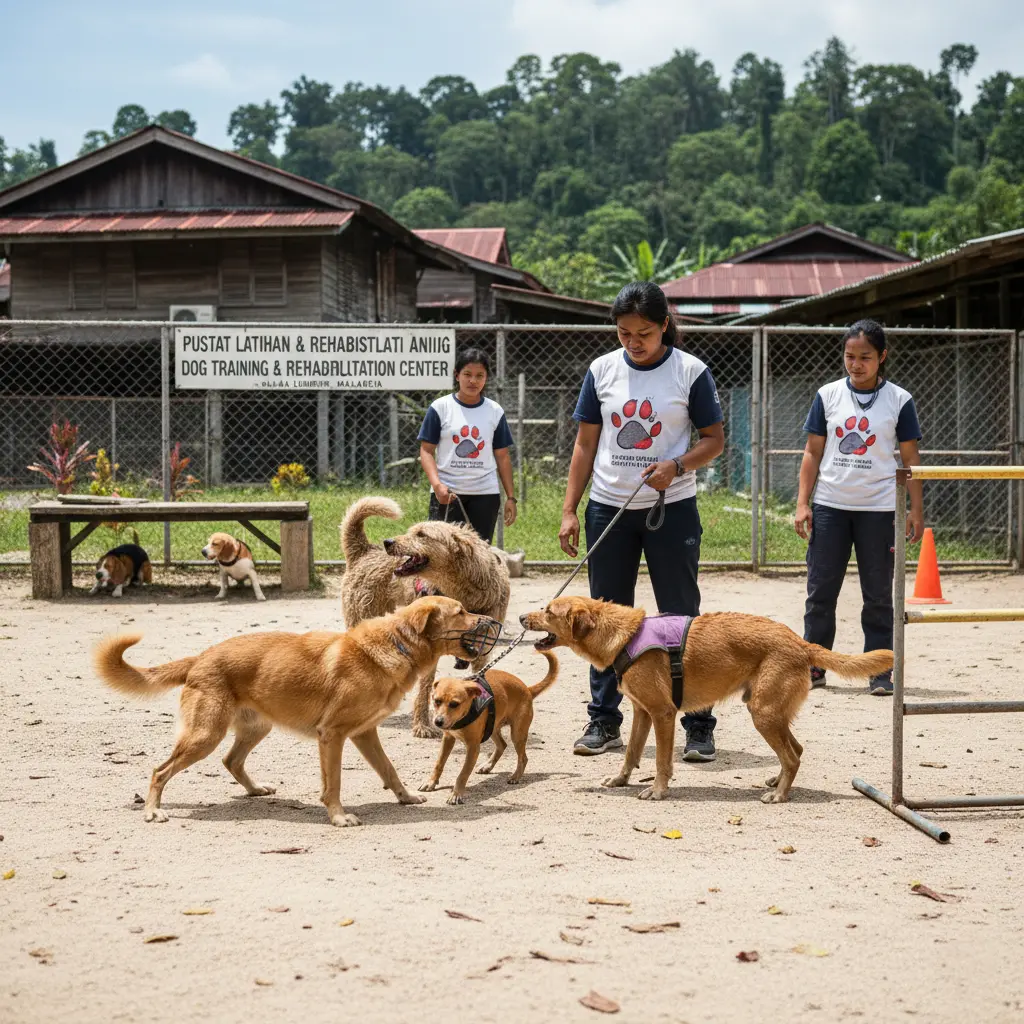
Dog behavior Malaysia reflects a mix of instinct, environment, and emotional response. Understanding your dog’s behavior—such as barking, jumping, or anxiety—helps you train them gently and effectively. With patience and positive methods, Malaysian pet parents can build real trust and a happier bond with their furry companions.
Table of Contents
1|When Your Dog’s Bark Feels Like a Mystery
If you live in Kuala Lumpur, you’ve probably heard your dog bark at delivery riders, thunder, or even the sound of keys jingling. Sometimes it’s cute, sometimes it’s chaos. But what if your dog’s bark isn’t random? What if it’s their version of “I’m scared,” “I’m excited,” or “I need your attention”?
As pet parents, we often think training is just about obedience. In reality, it’s about understanding. Dog behavior tells a story—about fear, boredom, love, and loyalty. Once you learn to read that story, training becomes more natural, more human, and more connected.
2|Why Dog Behavior Matters in Malaysia
Dog ownership in Malaysia has grown rapidly in the last five years. More people in Kuala Lumpur, Penang, and Johor Bahru are adopting dogs from shelters or buying them from pet shops. Yet many still struggle with barking, separation anxiety, and even aggression — common patterns of dog behavior Malaysia that need understanding rather than punishment.
In Malaysia, behavioural issues dogs Malaysia often stem from a mix of environment, stress, and lack of training consistency.
According to local research published on One Health Outlook, Malaysian dog owners often lack formal behavior training knowledge, which can lead to misunderstandings between pets and humans.
Understanding dog behavior Malaysia trends isn’t just about being a better trainer—it’s about being a better companion. It helps prevent stress, reduce behavioral issues, and improve your dog’s health and happiness.
Professional trainers often address behavioural issues dogs Malaysia by combining structured routines with positive reinforcement.
🐾 Related Reading: Dog Training Malaysia (2025): From Barking Chaos to Calm Confidence

3|Common Dog Behavior Problems & What They Mean
Let’s decode the most common dog behavior Malaysia problems Malaysian owners face — especially those living in high-rise apartments.
1. Excessive Barking
Why it happens: boredom, fear, loneliness, or excitement.
What to do: identify the trigger; redirect attention with chew toys or gentle commands.
Avoid yelling—it reinforces anxiety instead of calming your dog.
2. Jumping on People
Dogs jump because they’re happy, but it can scare guests or kids. Train them by ignoring jumping behavior and rewarding calm sits.
3. Destructive Chewing
If your slippers have become chew toys, it’s not personal—it’s a sign of pent-up energy or separation anxiety. Rotate safe chew toys and establish play routines.
4. Aggression or Fearful Reactions
Aggression in dogs can stem from fear, poor socialization, or health issues. Consult a vet or certified trainer if your dog growls, snaps, or avoids touch.
5. Separation Anxiety
This is a growing issue in Malaysian households where pet parents work long hours. Create a “comfort zone” at home—leave worn clothes, play calm music, or use slow feeders to distract anxiety.
If your slippers have become chew toys, it’s not personal—it’s a sign of pent-up energy or separation anxiety. These are the behavioural issues dogs Malaysia families often face when dogs lack structured daily engagement.
🏠 Related Reading: Pet Boarding Malaysia (2025): Loving Care Beyond Separation
4|How to Read Your Dog’s Body Language
Dogs speak a language we often miss—their tails, ears, eyes, and body positions tell you everything.
| Body Signal | Meaning | Action |
|---|---|---|
| Tail wagging low & slow | Nervous excitement | Keep calm, lower stimulation |
| Ears pinned back | Fear or submission | Avoid direct eye contact |
| Yawning or licking lips | Stress or discomfort | Pause training, offer reassurance |
| Loose body posture | Relaxed & trusting | Continue gentle interaction |
Understanding dog behaviour Malaysia cues helps you recognize early stress signs and prevent bigger problems later.
🐶 Related Reading: Dog Grooming KL (2025): Gentle, Safe & Stylish Care for Your Loyal Friend

5|Training Tips Backed by Experts
Training isn’t about dominance—it’s about communication.
According to Oyen Malaysia, positive reinforcement remains the best way to shape behavior without fear or punishment.
Step-by-Step Approach
Set Clear Commands – Short, consistent words (“Sit,” “Stay,” “Come”).
Reward Immediately – Use treats or praise the moment your dog obeys.
Stay Consistent – Everyone in your family should use the same commands.
Gradually Reduce Rewards – Replace treats with affection or play.
Home Training Tips for Malaysian Weather
Train early morning or late evening to avoid heat.
Use indoor spaces for short sessions (10–15 mins).
Keep water nearby and reward with frozen treats during hot days.
Common Mistakes to Avoid
Yelling when your dog misbehaves (creates fear).
Inconsistency (confuses your pet).
Over-training (leads to burnout and stress).
When in doubt, consult certified trainers from the Malaysian Kennel Association (MKA) or local behavior specialists.
6|Dog Behavior in Urban Malaysia
Living in Kuala Lumpur means tight apartments, loud traffic, and limited outdoor space. These environmental stressors directly affect dog behaviour problems Malaysia, often leading to anxiety-driven barking or destructive chewing if unaddressed.
Understanding local conditions behind dog behavior Malaysia patterns allows you to train smarter and create routines that fit Malaysian lifestyles.
Tips for Urban Pet Parents
Walks twice a day – Even short ones help release energy.
Socialization – Introduce your dog to other pets gradually at parks like Desa ParkCity.
Noise sensitivity – Expose dogs to soft background sounds (TV, music) to desensitize them.
Respect neighbors – Control barking through positive routines, not punishment.
Cultural sensitivity also matters—some areas in Malaysia view dogs differently. Be a responsible, respectful pet owner by leashing your dog and maintaining cleanliness.
7|Building Trust: The Emotional Side of Training
Training works best when built on love, not control.
Your dog isn’t just a pet—they’re your emotional mirror. When you’re calm, they’re calm; when you’re anxious, they sense it.
Spend quality time: morning walks, gentle grooming, evening cuddles. You can even visit friendly pet salons like Hairy Home Maluri where grooming feels like bonding, not stress.
Trust isn’t built in a week—it grows from empathy, routine, and understanding your pet’s emotions day by day.

8|Your 3-Step Action Plan for Better Behavior
| Step | Action | Goal |
|---|---|---|
| 🧠 Step 1 | Observe daily signals (body, bark, mood) | Build awareness |
| 🐕 Step 2 | Apply gentle training & reward calm behavior | Reinforce trust |
| ❤️ Step 3 | Seek expert advice when behavior escalates | Ensure safety & growth |
📘 Reference Guide: Pet Nutrition Malaysia (2025): Balanced Meals for Healthier Pets
9|Frequently Asked Questions (FAQ)
Q1. Why does my dog bark excessively at strangers?
It’s often due to fear or excitement. Gradual exposure and positive reinforcement can help.
Q2. My dog chews everything when I’m at work—what should I do?
That’s separation anxiety. Provide enrichment toys, soft background noise, or consider part-time boarding.
Q3. How can I train my dog to stop jumping?
Ignore jumping and reward calm sits—never push or yell.
Q4. What’s the best time to train my dog in Malaysia?
Early morning or evening to avoid the heat.
Q5. When should I call a professional trainer?
If aggression, fear, or persistent disobedience continues after consistent effort.
10|Conclusion: Understanding Your Dog Is the Real Training
Every bark, every tail wag, and every mistake — it’s all part of your dog behavior Malaysia story. Training isn’t just obedience; it’s emotional understanding.
Once you start reading signals, even the toughest behavioural issues dogs Malaysia can turn into moments of connection and trust.
In Malaysia’s busy city life, dogs adapt to our world with loyalty and patience. The least we can do is try to understand theirs. When you learn to read your dog’s signals, you stop reacting — and start connecting.
So the next time your pup misbehaves, pause. Observe. Speak softly. Reward calmness. That’s how you transform obedience into trust, and training into love.
Because a well-behaved dog isn’t one that fears correction — it’s one that feels safe with you.
💬 Your Turn
If this guide helped you understand your furry friend better, explore more care tips from Hairy Home’s family of pet lovers:
And remember — good behavior starts with good understanding. 🐶❤️



